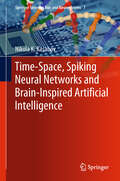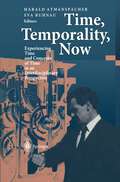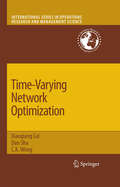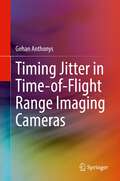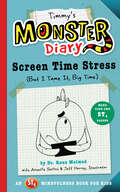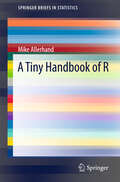- Table View
- List View
Time-Space, Spiking Neural Networks and Brain-Inspired Artificial Intelligence (Springer Series on Bio- and Neurosystems #7)
by Nikola K. KasabovSpiking neural networks (SNN) are biologically inspired computational models that represent and process information internally as trains of spikes. This monograph book presents the classical theory and applications of SNN, including original author’s contribution to the area. The book introduces for the first time not only deep learning and deep knowledge representation in the human brain and in brain-inspired SNN, but takes that further to develop new types of AI systems, called in the book brain-inspired AI (BI-AI). BI-AI systems are illustrated on: cognitive brain data, including EEG, fMRI and DTI; audio-visual data; brain-computer interfaces; personalized modelling in bio-neuroinformatics; multisensory streaming data modelling in finance, environment and ecology; data compression; neuromorphic hardware implementation. Future directions, such as the integration of multiple modalities, such as quantum-, molecular- and brain information processing, is presented in the last chapter. The book is a research book for postgraduate students, researchers and practitioners across wider areas, including computer and information sciences, engineering, applied mathematics, bio- and neurosciences.
Time, Temporality, Now: Experiencing Time and Concepts of Time in an Interdisciplinary Perspective
by Harald Atmanspacher Eva RuhnauThe essays in this topical volume inquire into one of the most fundamental issues of philosophy and of the cognitive and natural sciences: the riddle of time. The central feature is the tension between the experience and the conceptualization of time, reflecting an apparently unavoidable antinomy of subjective first-person accounts and objective traditional science. Is time based in the physics of inanimate matter, or does it originate in the operation of our minds? Is it essential for the constitution of reality, or is it just an illusion? Issues of time, temporality, and nowness are paradigms for interdisciplinary work in many contemporary fields of research. The authors of this volume discuss profoundly the mutual relationships and inspiring perspectives. They address a general audience.
Time-Triggered Communication (Embedded Systems)
by Roman ObermaisserTime-Triggered Communication helps readers build an understanding of the conceptual foundation, operation, and application of time-triggered communication, which is widely used for embedded systems in a diverse range of industries. This book assembles contributions from experts that examine the differences and commonalities of the most significant protocols including: TTP, FlexRay, TTEthernet, SAFEbus, TTCAN, and LIN. Covering the spectrum, from low-cost time-triggered fieldbus networks to ultra-reliable time-triggered networks used for safety-critical applications, the authors illustrate the inherent benefits of time-triggered communication in terms of predictability, complexity management, fault-tolerance, and analytical dependability modeling, which are key aspects of safety-critical systems. Examples covered include FlexRay in cars, TTP in railway and avionic systems, and TTEthernet in aerospace applications. Illustrating key concepts based on real-world industrial applications, this book: Details the underlying concepts and principles of time-triggered communication Explores the properties of a time-triggered communication system, contrasting its strengths and weaknesses Focuses on the core algorithms applied in many systems, including those used for clock synchronization, startup, membership, and fault isolation Describes the protocols that incorporate presented algorithms Covers tooling requirements and solutions for system integration, including scheduling The information in this book is extremely useful to industry leaders who design and manufacture products with distributed embedded systems based on time-triggered communication. It also benefits suppliers of embedded components or development tools used in this area. As an educational tool, this material can be used to teach students and working professionals in areas including embedded systems, computer networks, system architectures, dependability, real-time systems, and automotive, avionics, and industrial control systems.
Time-Triggered Communication (Embedded Systems)
by Roman ObermaisserTime-Triggered Communication helps readers build an understanding of the conceptual foundation, operation, and application of time-triggered communication, which is widely used for embedded systems in a diverse range of industries. This book assembles contributions from experts that examine the differences and commonalities of the most significant protocols including: TTP, FlexRay, TTEthernet, SAFEbus, TTCAN, and LIN. Covering the spectrum, from low-cost time-triggered fieldbus networks to ultra-reliable time-triggered networks used for safety-critical applications, the authors illustrate the inherent benefits of time-triggered communication in terms of predictability, complexity management, fault-tolerance, and analytical dependability modeling, which are key aspects of safety-critical systems. Examples covered include FlexRay in cars, TTP in railway and avionic systems, and TTEthernet in aerospace applications. Illustrating key concepts based on real-world industrial applications, this book: Details the underlying concepts and principles of time-triggered communication Explores the properties of a time-triggered communication system, contrasting its strengths and weaknesses Focuses on the core algorithms applied in many systems, including those used for clock synchronization, startup, membership, and fault isolation Describes the protocols that incorporate presented algorithms Covers tooling requirements and solutions for system integration, including scheduling The information in this book is extremely useful to industry leaders who design and manufacture products with distributed embedded systems based on time-triggered communication. It also benefits suppliers of embedded components or development tools used in this area. As an educational tool, this material can be used to teach students and working professionals in areas including embedded systems, computer networks, system architectures, dependability, real-time systems, and automotive, avionics, and industrial control systems.
Time-Varying Image Processing and Moving Object Recognition: Proceedings of the 4th International Workshop Florence, Italy, June 10-11, 1993
by V. CappelliniIn the area of Digital Image Processing the new area of "Time-Varying Image Processing and Moving Oject Recognition" is contributing to impressive advances in several fields. Presented in this volume are new digital image processing and recognition methods, implementation techniques and advanced applications such as television, remote sensing, biomedicine, traffic, inspection, and robotics. New approaches (such as digital transforms, neural networks) for solving 2-D and 3-D problems are described. Many papers concentrate on motion estimation and recognition i.e. tracking of moving objects. Overall, the book describes the state-of-the-art (theory, implementation, applications) of this developing area, together with future trends. The work will be of interest not only to researchers, professors and students in university departments of engineering, communications, computers and automatic control, but also to engineers and managers of industries concerned with computer vision, manufacturing, automation, robotics and quality control.
Time-Varying Image Processing and Moving Object Recognition, 4
by V. CappelliniNew digital image processing and recognition methods, implementation techniques and advanced applications (television, remote sensing, biomedicine, traffic, inspection, robotics, etc.) are presented in this volume. Novel approaches (i.e. digital filters, source coding, neural networks etc.) for solving 2-D and 3-D problems are described. Many papers focus on the motion estimation and tracking recognition of moving objects. The increasingly important field of Cultural Heritage is also covered. Some papers are more theoretical or of review nature, while others contain new implementations and applications. Generally the book presents - for the above outlined area - the state of the art (theory, implementation, applications) with future trends.This book will be of interest not only to researchers, professors and students in university departments of engineering, communications, computers and automatic control, but also to engineers and managers of industries concerned with computer vision, manufacturing, automation, robotics and quality control.
Time-Varying Network Optimization (International Series in Operations Research & Management Science #103)
by Dan Sha C. K. WongThis text describes a series of models, propositions, and algorithms developed in recent years on time-varying networks. References and discussions on relevant problems and studies that have appeared in the literature are integrated in the book. Its eight chapters consider problems including the shortest path problem, the minimum-spanning tree problem, the maximum flow problem, and many more. The time-varying traveling salesman problem and the Chinese postman problem are presented in a chapter together with the time-varying generalized problem. While these topics are examined within the framework of time-varying networks, each chapter is self-contained so that each can be read – and used – separately.
Times of Convergence. Technologies Across Learning Contexts: Third European Conference on Technology Enhanced Learning, EC-TEL 2008, Maastricht, The Netherlands, September 16-19, 2008, Proceedings (Lecture Notes in Computer Science #5192)
by Pierre Dillenbourg Marcus SpechtThe European Conference on Technology-Enhanced Learning (EC-TEL 2008) was the third event of a series that started in 2006. The two first editions were organized by Pro- Learn (http://www.prolearn-project.org/), a European Network of Excellence. In 2008, several members of Kaleidoscope, the other European Network of Excellence (http://www.noe-kaleidoscope.org/pub/), joined as co-chair, committee members, reviewers and authors. These two networks are no longer funded, but our aim was to turn EC-TEL into a sustainable series of high-quality events and thereby to contribute to the scientific landscape of technology-enhanced learning. A new network, named STELLAR, will be launched in 2009, with members from both existing networks as well as new members and will support the future editions of this conference. The scope of EC-TEL 2008 covered the different fields of learning technologies: e- cation, psychology, computer science. The contributions in this volume address the - sign of innovative environments, computational models and architectures, results of empirical studies on socio-cognitive processes, field studies regarding the use of te- nologies in context, collaborative processes, pedagogical scenarios, reusable learning objects and emerging objects, groups and communities, learning networks, interaction analysis, metadata, personalization, collaboration scripts, learning adaptation, collabo- tive environments, resources, tangible tools, as well as learning management systems.
Timing
by Sachin SapatnekarStatistical timing analysis is an area of growing importance in nanometer te- nologies‚ as the uncertainties associated with process and environmental var- tions increase‚ and this chapter has captured some of the major efforts in this area. This remains a very active field of research‚ and there is likely to be a great deal of new research to be found in conferences and journals after this book is published. In addition to the statistical analysis of combinational circuits‚ a good deal of work has been carried out in analyzing the effect of variations on clock skew. Although we will not treat this subject in this book‚ the reader is referred to [LNPS00‚ HN01‚ JH01‚ ABZ03a] for details. 7 TIMING ANALYSIS FOR SEQUENTIAL CIRCUITS 7.1 INTRODUCTION A general sequential circuit is a network of computational nodes (gates) and memory elements (registers). The computational nodes may be conceptualized as being clustered together in an acyclic network of gates that forms a c- binational logic circuit. A cyclic path in the direction of signal propagation 1 is permitted in the sequential circuit only if it contains at least one register . In general, it is possible to represent any sequential circuit in terms of the schematic shown in Figure 7.1, which has I inputs, O outputs and M registers. The registers outputs feed into the combinational logic which, in turn, feeds the register inputs. Thus, the combinational logic has I + M inputs and O + M outputs.
Timing Analysis and Optimization of Sequential Circuits
by Naresh Maheshwari S. SapatnekarRecent years have seen rapid strides in the level of sophistication of VLSI circuits. On the performance front, there is a vital need for techniques to design fast, low-power chips with minimum area for increasingly complex systems, while on the economic side there is the vastly increased pressure of time-to-market. These pressures have made the use of CAD tools mandatory in designing complex systems. Timing Analysis and Optimization of Sequential Circuits describes CAD algorithms for analyzing and optimizing the timing behavior of sequential circuits with special reference to performance parameters such as power and area. A unified approach to performance analysis and optimization of sequential circuits is presented. The state of the art in timing analysis and optimization techniques is described for circuits using edge-triggered or level-sensitive memory elements. Specific emphasis is placed on two methods that are true sequential timing optimizations techniques: retiming and clock skew optimization. Timing Analysis and Optimization of Sequential Circuits covers the following topics: Algorithms for sequential timing analysis Fast algorithms for clock skew optimization and their applications Efficient techniques for retiming large sequential circuits Coupling sequential and combinational optimizations. Timing Analysis and Optimization of Sequential Circuits is written for graduate students, researchers and professionals in the area of CAD for VLSI and VLSI circuit design.
Timing Channels in Cryptography: A Micro-Architectural Perspective
by Chester Rebeiro Debdeep Mukhopadhyay Sarani BhattacharyaThis book deals with timing attacks on cryptographic ciphers. It describes and analyzes various unintended covert timing channels that are formed when ciphers are executed in microprocessors. The book considers modern superscalar microprocessors which are enabled with features such as multi-threaded, pipelined, parallel, speculative, and out-of order execution. Various timing attack algorithms are described and analyzed for both block ciphers as well as public-key ciphers. The interplay between the cipher implementation, the system architecture, and the attack's success is analyzed. Further hardware and software countermeasures are discussed with the aim of illustrating methods to build systems that can protect against these attacks.
Timing for Animation
by Tom SitoThe classic work on animation principles, now fully updated for the digital age.
Timing for Animation
by Tom SitoThe classic work on animation principles, now fully updated for the digital age.
Timing for Animation, 40th Anniversary Edition
by Harold Whitaker John HalasTiming for Animation has been one of the pillars of animation since it was first published in 1981. Now this 40th anniversary edition captures the focus of the original and enhances this new edition with fresh images, techniques, and advice from world-renowned animators. Not only does the text explore timing in traditional animation, but also timing in digital works. Vibrant illustrations and clear directions line the pages to help depict the various methods and procedures to bring your animation to life. Examples include timing for digital production, digital storyboarding in 2D, digital storyboarding in 3D, and the use of After Effects, as well as interactive games, television, animals, and more. Learn how animated scenes should be arranged in relation to each other, how much space should be used, and how long each drawing should be shown for maximum dramatic effect. All you need to breathe life into your animation is at your fingertips with Timing for Animation. Key Features: Fully revised and updated with modern examples and techniques Explores the fundamentals of timing, physics, and animation Perfect for the animation novice and the expert Get straight to the good stuff with simple, no-nonsense instruction on the key techniques like stretch and squash, animated cycles, overlapping, and anticipation. Trying to time weight, mood, and power can make or break an animation—get it right the first time with these tried and tested techniques. Authors Harold Whitaker was a BAFTA-nominated professional animator and educator for 40 years; many of his students number among today’s most outstanding animation artists. John Halas, known as "The father of British animation" and formerly of Halas & Batchelor Animation Studio, produced more than 2,000 animation films, including the legendary Animal Farm (1954) and the award-winning Dilemma (1981). He was also the founder and president of the International Animated Film Association (ASIFA) and former Chairman of the British Federation of Film Societies. Tom Sito is Professor of Animation at the University of Southern California and has written numerous books and articles on animation. Tom’s screen credits include Shrek (2001) and the Disney classics Who Framed Roger Rabbit (1988), The Little Mermaid (1989), Beauty and the Beast (1991), Aladdin (1992), and The Lion King (1994). In 1998, Tom was named by Animation Magazine as one of the 100 Most Important People in Animation.
Timing for Animation, 40th Anniversary Edition
by Harold Whitaker John HalasTiming for Animation has been one of the pillars of animation since it was first published in 1981. Now this 40th anniversary edition captures the focus of the original and enhances this new edition with fresh images, techniques, and advice from world-renowned animators. Not only does the text explore timing in traditional animation, but also timing in digital works. Vibrant illustrations and clear directions line the pages to help depict the various methods and procedures to bring your animation to life. Examples include timing for digital production, digital storyboarding in 2D, digital storyboarding in 3D, and the use of After Effects, as well as interactive games, television, animals, and more. Learn how animated scenes should be arranged in relation to each other, how much space should be used, and how long each drawing should be shown for maximum dramatic effect. All you need to breathe life into your animation is at your fingertips with Timing for Animation. Key Features: Fully revised and updated with modern examples and techniques Explores the fundamentals of timing, physics, and animation Perfect for the animation novice and the expert Get straight to the good stuff with simple, no-nonsense instruction on the key techniques like stretch and squash, animated cycles, overlapping, and anticipation. Trying to time weight, mood, and power can make or break an animation—get it right the first time with these tried and tested techniques. Authors Harold Whitaker was a BAFTA-nominated professional animator and educator for 40 years; many of his students number among today’s most outstanding animation artists. John Halas, known as "The father of British animation" and formerly of Halas & Batchelor Animation Studio, produced more than 2,000 animation films, including the legendary Animal Farm (1954) and the award-winning Dilemma (1981). He was also the founder and president of the International Animated Film Association (ASIFA) and former Chairman of the British Federation of Film Societies. Tom Sito is Professor of Animation at the University of Southern California and has written numerous books and articles on animation. Tom’s screen credits include Shrek (2001) and the Disney classics Who Framed Roger Rabbit (1988), The Little Mermaid (1989), Beauty and the Beast (1991), Aladdin (1992), and The Lion King (1994). In 1998, Tom was named by Animation Magazine as one of the 100 Most Important People in Animation.
Timing Jitter in Time-of-Flight Range Imaging Cameras
by Gehan AnthonysThis book explains how depth measurements from the Time-of-Flight (ToF) range imaging cameras are influenced by the electronic timing-jitter. The author presents jitter extraction and measurement techniques for any type of ToF range imaging cameras. The author mainly focuses on ToF cameras that are based on the amplitude modulated continuous wave (AMCW) lidar techniques that measure the phase difference between the emitted and reflected light signals. The book discusses timing-jitter in the emitted light signal, which is sensible since the light signal of the camera is relatively straightforward to access. The specific types of jitter that present on the light source signal are investigated throughout the book. The book is structured across three main sections: a brief literature review, jitter measurement, and jitter influence in AMCW ToF range imaging.
Timing Optimization Through Clock Skew Scheduling
by Ivan S. Kourtev Eby G. Friedman Baris TaskinHistory of the Book The last three decades have witnessed an explosive development in integrated circuit fabrication technologies. The complexities of cur rent CMOS circuits are reaching beyond the 100 nanometer feature size and multi-hundred million transistors per integrated circuit. To fully exploit this technological potential, circuit designers use sophisticated Computer-Aided Design (CAD) tools. While supporting the talents of innumerable microelectronics engineers, these CAD tools have become the enabling factor responsible for the successful design and implemen tation of thousands of high performance, large scale integrated circuits. This research monograph originated from a body of doctoral disserta tion research completed by the first author at the University of Rochester from 1994 to 1999 while under the supervision of Prof. Eby G. Friedman. This research focuses on issues in the design of the clock distribution net work in large scale, high performance digital synchronous circuits and particularly, on algorithms for non-zero clock skew scheduling. During the development of this research, it has become clear that incorporating timing issues into the successful integrated circuit design process is of fundamental importance, particularly in that advanced theoretical de velopments in this area have been slow to reach the designers' desktops.
Timing Optimization Through Clock Skew Scheduling
by Ivan S. Kourtev Baris Taskin Eby G. FriedmanThis book details timing analysis and optimization techniques for circuits with level-sensitive memory elements. It contains a linear programming formulation applicable to the timing analysis of large scale circuits and includes a delay insertion methodology that improves the efficiency of clock skew scheduling. Coverage also provides a framework for and results from implementing timing optimization algorithms in a parallel computing environment.
Timing Performance of Nanometer Digital Circuits Under Process Variations (Frontiers in Electronic Testing #39)
by Victor Champac Jose Garcia GervacioThis book discusses the digital design of integrated circuits under process variations, with a focus on design-time solutions. The authors describe a step-by-step methodology, going from logic gates to logic paths to the circuit level. Topics are presented in comprehensively, without overwhelming use of analytical formulations. Emphasis is placed on providing digital designers with understanding of the sources of process variations, their impact on circuit performance and tools for improving their designs to comply with product specifications. Various circuit-level “design hints” are highlighted, so that readers can use then to improve their designs. A special treatment is devoted to unique design issues and the impact of process variations on the performance of FinFET based circuits. This book enables readers to make optimal decisions at design time, toward more efficient circuits, with better yield and higher reliability.
Timmy's Monster Diary: Screen Time Stress (But I Tame It, Big Time) (Monster Diaries #2)
by Raun Melmed Annette SextonUsing the "Time-Telling" and "ST4" techniques developed by Dr. Raun Melmed of the Melmed Center in Arizona, Timmy's Monster Diary teaches kids how to self-moniter the amount of time they spend on technology.
A Tinkerer's Guide to CNC Basics: Master the fundamentals of CNC machining, G-Code, 2D Laser machining and fabrication techniques
by Samer NajiaGet started with CNC machining using this hands-on guide that tells you exactly what you need to know without overloading you with useless theoryKey FeaturesGet started with the basics of CNC machining and set up your own computerized workshopExplore loads of do-it-yourself projects to practice what you’ve learnedTake advantage of the potential of home machining thanks to the power of CNCBook DescriptionUntil recently, Computer Numerical Control (CNC) machines belonged to the realm of heavy industry, but as technology becomes cheaper and smaller, these machines now can be used in home workshops. It’s not easy to get started, though, but thanks to this guide, you’ll be ready to take on a variety of projects in no time. A Tinkerer’s Guide to CNC Basics contains everything you need to get set up at home with computer-controlled machining and fabrication. Sparing you the theory, this project-laden guide helps you learn by doing. Once you’ve got to grips with the principles of CNC and installed the 3018 Pro CNC machine, you’ll gradually move from simple projects such as basic engraving to more complex milling and machining techniques. You’ll even learn how to upgrade your machine to accomplish more sophisticated designs. The plethora of projects in this book will keep you busy and give you the practice you need to get started with your computerized workshop. By the end of the book, your computerized home workshop will be one step closer to realization, and your machining skills will be taken to the next level.What you will learnConfigure, calibrate, provision, and test your CNC machineAdd a laser engraver to your machine for finer precision cuttingUse the machine to fabricate new components for itselfExplore the design impacts of carving on a rotary axisAdapt other machines for CNCEngrave opaque and semi-opaque materialsCool your machine with an air assist systemDesign and develop a customized laser mountWho this book is forThis book is for tinkerers, hobbyists, and craft aficionados comfortable using hand tools, aspiring to accelerate or develop more complex and challenging projects. Before starting this book, you should be comfortable around basic shop tools, as well as have a basic understanding of computers. While the book will speak to the specifics around the electronics of CNC machines, the terms used, such as motherboard, USB, positive/negative terminal, and power supply should not be too daunting to understand.
Tiny Android Projects Using Kotlin
by Denis Panjuta Loveth NwokikeIn today’s fast-paced world, Android development is a rapidly evolving field that requires regular updates to keep up with the latest trends and technologies. Tiny Android Projects Using Kotlin is an excellent resource for developers who want to learn to build Android applications using the latest tools and frameworks. KEY FEATURES • Teaches building Android apps using Kotlin, XML, and Jetpack Compose • Includes saving data on the device using the Room database library • Teaches communication between an Android device and data on the internet using REST API • Shows how to create different Android menu navigations using Jetpack Compose • Introduces the most architectures used in Android Projects and implements MVVM With Kotlin being the most preferred language for Android development, this book provides a practical, hands-on approach to learning the language and building high-quality Android apps using Kotlin, XML, and Jetpack Compose.
Tiny Android Projects Using Kotlin
by Denis Panjuta Loveth NwokikeIn today’s fast-paced world, Android development is a rapidly evolving field that requires regular updates to keep up with the latest trends and technologies. Tiny Android Projects Using Kotlin is an excellent resource for developers who want to learn to build Android applications using the latest tools and frameworks. KEY FEATURES • Teaches building Android apps using Kotlin, XML, and Jetpack Compose • Includes saving data on the device using the Room database library • Teaches communication between an Android device and data on the internet using REST API • Shows how to create different Android menu navigations using Jetpack Compose • Introduces the most architectures used in Android Projects and implements MVVM With Kotlin being the most preferred language for Android development, this book provides a practical, hands-on approach to learning the language and building high-quality Android apps using Kotlin, XML, and Jetpack Compose.
A Tiny Handbook of R (SpringerBriefs in Statistics)
by Mike AllerhandThis Brief provides a roadmap for the R language and programming environment with signposts to further resources and documentation.
TinyML Cookbook: Combine machine learning with microcontrollers to solve real-world problems
by Gian Marco IodiceOver 70 recipes to help you develop smart applications on Arduino Nano 33 BLE Sense, Raspberry Pi Pico, and SparkFun RedBoard Artemis Nano using the power of machine learning Purchase of the print or Kindle book includes a free eBook in PDF format.Key FeaturesOver 20+ new recipes, including recognizing music genres and detecting objects in a sceneRun on-device ML with TensorFlow Lite for Microcontrollers, Edge Impulse, TVM, and scikit-learnExplore cutting-edge technologies, such as on-device training for updating models without data leaving the deviceBook DescriptionDiscover the incredible world of tiny Machine Learning (tinyML) and create smart projects using real-world data sensors with the Arduino Nano 33 BLE Sense, Raspberry Pi Pico, and SparkFun RedBoard Artemis Nano. TinyML Cookbook, Second Edition, will show you how to build unique end-to-end ML applications using temperature, humidity, vision, audio, and accelerometer sensors in different scenarios. These projects will equip you with the knowledge and skills to bring intelligence to microcontrollers. You'll train custom models from weather prediction to real-time speech recognition using TensorFlow and Edge Impulse. Expert tips will help you squeeze ML models into tight memory budgets and accelerate performance using CMSIS-DSP. This improved edition includes new recipes featuring an LSTM neural network to recognize music genres and the Faster-Objects-More-Objects (FOMO) algorithm for detecting objects in a scene. Furthermore, you'll take your tinyML solutions to the next level with microTVM, microNPU, scikit-learn, and on-device learning. This book will help you stay up to date with the latest developments in the tinyML community and give you the knowledge to build unique projects with microcontrollers!What you will learnUnderstand the microcontroller programming fundamentalsWork with real-world sensors, such as the microphone, camera, and accelerometerImplement an app that responds to human voice or recognizes music genresLeverage transfer learning with FOMO and KerasLearn best practices on how to use the CMSIS-DSP libraryCreate a gesture-recognition app to build a remote controlDesign a CIFAR-10 model for memory-constrained microcontrollersTrain a neural network on microcontrollersWho this book is forThis book is ideal for machine learning engineers or data scientists looking to build embedded/edge ML applications and IoT developers who want to add machine learning capabilities to their devices. If you’re an engineer, student, or hobbyist interested in exploring tinyML, then this book is your perfect companion. Basic familiarity with C/C++ and Python programming is a prerequisite; however, no prior knowledge of microcontrollers is necessary to get started with this book.
